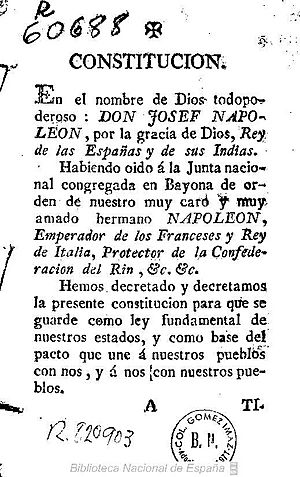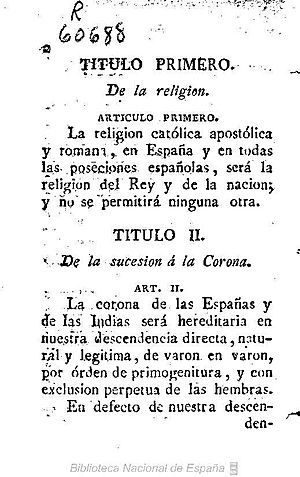Bayonne Statute facts for kids
The Bayonne Statute (also called the Bayonne Constitution or Bayonne Charter) was a special set of laws for Spain. It was approved in Bayonne, France, on July 6, 1808. This document was meant to be the main rulebook for Joseph Bonaparte when he became king of Spain.
The statute was designed by Napoleon Bonaparte's ideas, but it also tried to include some Spanish traditions. However, most of its rules were never truly put into action. Joseph I's time as king of Spain was mostly spent fighting in the Peninsular War.
Why the Bayonne Statute Was Created
In 1808, Spain and Napoleon's French Empire had a shaky alliance. A big event called the Mutiny of Aranjuez happened on March 17, 1808. This event removed the king's main minister, Manuel de Godoy, Prince of the Peace. It also led to King Charles IV of Spain giving up his throne on March 19, 1808.
His son, Ferdinand VII of Spain, briefly became king. But Napoleon had other plans. He decided that a member of his own family should rule Spain. So, he chose his older brother, Joseph.
On May 5, 1808, Charles IV gave up his rights to the Spanish Crown to Napoleon. Later that same day, Ferdinand VII also gave up his rights to his father. This meant the Crown effectively passed to Napoleon. Charles, Ferdinand, and other Spanish royals then went to France.
Napoleon wanted to make his rule seem legal. So, he told his general, Joachim Murat, to gather a group of important Spanish people in Bayonne. This group, called the Cortes, had thirty members. Their job was to help write and approve the new laws for Joseph's government.
However, many people in Spain were already rebelling. The Dos de Mayo Uprising happened in Madrid, and other uprisings followed. Because of this, only about a third of the invited Spanish leaders actually showed up in Bayonne. On June 4, 1808, Napoleon officially made his brother Joseph the king of Spain. Joseph was declared king in Madrid on July 25. The small group of Cortes members started meeting in Bayonne on June 15. They began writing the "constitution" based on a draft Napoleon gave them. It was officially announced on July 8.
What the Bayonne Statute Said
The Bayonne Statute seemed to limit the king's power in many ways. But these limits were not very strong in practice. It planned for a government with three parts (a tricameral legislature). It also called for nine ministers, more than the previous Spanish government had. The statute also wanted an independent court system. It recognized many individual freedoms, but not freedom of religion.
Even though Napoleon's ideas influenced it, the Spanish leaders who helped write it made sure of some things. They kept Catholicism as the official state religion. All other religions were banned. The statute even started with the words, "In the name of God Almighty," following Spanish tradition.
In reality, most parts of the statute were never used. During the time Joseph Bonaparte ruled Spain, the French military was in charge. They often ignored the constitution. Most decisions were made by Napoleon and his generals, not by King Joseph.
Still, the French-controlled government in Spain tried to make some important changes. They tried to end feudalism (a system where land was controlled by lords). They also abolished the Spanish Inquisition, a powerful religious court. Many monasteries and military groups were shut down. They also tried to stop new mayorazgos (a system where family wealth was passed down to one heir). The country was divided into new areas, similar to French departments. They removed internal customs borders and many state monopolies. They also ended the Mesta, a powerful group of sheep owners, and a tax called the Voto de Santiago. Many state-owned factories were sold to private owners. They also started to bring in the Napoleonic Code, a new system of laws, to Spain.

See also
 In Spanish: Estatuto de Bayona para niños
In Spanish: Estatuto de Bayona para niños
- List of constitutions of Spain
- Spanish Constitution of 1812




